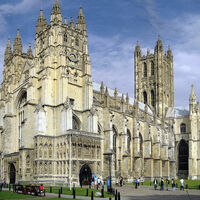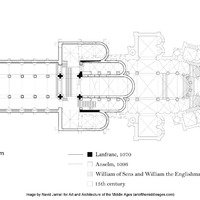Canterbury Cathedral
Type:
Churches,
Stained-glass windows
Date:
1070s–80s (Norman rebuilding), 1130 (choir and presbytery), 1175–84 (east end), ca. 1185–1220 (stained glass), fourteenth century to 1405 (nave)
Location or Findspot (Modern-Day Country):
United Kingdom
Description:
Canterbury Cathedral was rebuilt by the Normans (1070s–80s) on the site of an existing cathedral after the latter was damaged during Viking raids and a fire in 1067. The new choir and presbytery (area around the main altar) were dedicated in 1130. Yet another fire in 1174 required significant rebuilding (1175–84), a phase associated with the architects William of Sens (France), who died after falling from scaffolding, and William the Englishman, who then took over.
As one moves eastward and upwards in the cathedral, material richness increases. Building activity following the murder of Archbishop Thomas Becket (r. 1162–70) and his subsequent canonization in 1173 reflected the desire to showcase Becket's relics and accommodate increasing numbers of pilgrims (many of whom left the site with souvenir ampullae). Canterbury Cathedral became the third-most important pilgrimage destination in Europe after Santiago de Compostela and Rome.
A twelfth-century panel of stained glass from Canterbury Cathedral is the earliest-known image of pilgrims on their way to visit Becket's tomb. The panel was originally thought to be the work of Victorian restorers, but close inspection revealed that the majority of the pieces (excluding most of the pilgrims' heads) were indeed created by medieval glaziers. Examination of the panel also revealed an inscription that is now only visible under raking light: "PEREGRINI ST" (pilgrims of the saint). The windows in the Trinity Chapel also retain much of their original glass (ca. 1185–1220) and depict many of Becket's recorded miracles.
As one moves eastward and upwards in the cathedral, material richness increases. Building activity following the murder of Archbishop Thomas Becket (r. 1162–70) and his subsequent canonization in 1173 reflected the desire to showcase Becket's relics and accommodate increasing numbers of pilgrims (many of whom left the site with souvenir ampullae). Canterbury Cathedral became the third-most important pilgrimage destination in Europe after Santiago de Compostela and Rome.
A twelfth-century panel of stained glass from Canterbury Cathedral is the earliest-known image of pilgrims on their way to visit Becket's tomb. The panel was originally thought to be the work of Victorian restorers, but close inspection revealed that the majority of the pieces (excluding most of the pilgrims' heads) were indeed created by medieval glaziers. Examination of the panel also revealed an inscription that is now only visible under raking light: "PEREGRINI ST" (pilgrims of the saint). The windows in the Trinity Chapel also retain much of their original glass (ca. 1185–1220) and depict many of Becket's recorded miracles.
Relevant Textbook Chapter(s):
8
Repository and Online Resources:
• Take a virtual tour of Canterbury Cathedral.
• Visit the website of Canterbury Cathedral to read more and watch a video about the 2018 discovery that the pilgrimage panel was from the twelfth century.
• Watch a video recreation of the Trinity Chapel and the shrine of Thomas Becket ca. 1408.
Image Credits:
Wikimedia Commons, Jill Caskey, Navid Jamali







